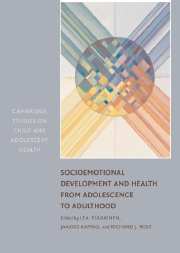Book contents
- Frontmatter
- Contents
- List of Contributors
- Preface
- Introduction
- PART I LONGITUDINAL AND BEHAVIORAL GENETIC APPROACHES
- PART II ADOLESCENT HEALTH-RELATED BEHAVIOR AND ADULT HEALTH
- 4 Body Size and Overweight From Birth to Adulthood
- 5 Pubertal Development and Health-Related Behavior
- 6 Genetic and Environmental Influences on the Initiation and Continuation of Smoking and Drinking
- 7 Self-Rated Health: Precursors and Implications
- PART III SOCIOEMOTIONAL BEHAVIOR IN EARLY ADOLESCENCE
- PART IV LIFE COURSE AND HEALTH
- Summary and Future Directions
- References
- Author Index
- Subject Index
7 - Self-Rated Health: Precursors and Implications
Published online by Cambridge University Press: 07 December 2009
- Frontmatter
- Contents
- List of Contributors
- Preface
- Introduction
- PART I LONGITUDINAL AND BEHAVIORAL GENETIC APPROACHES
- PART II ADOLESCENT HEALTH-RELATED BEHAVIOR AND ADULT HEALTH
- 4 Body Size and Overweight From Birth to Adulthood
- 5 Pubertal Development and Health-Related Behavior
- 6 Genetic and Environmental Influences on the Initiation and Continuation of Smoking and Drinking
- 7 Self-Rated Health: Precursors and Implications
- PART III SOCIOEMOTIONAL BEHAVIOR IN EARLY ADOLESCENCE
- PART IV LIFE COURSE AND HEALTH
- Summary and Future Directions
- References
- Author Index
- Subject Index
Summary
INTRODUCTION
Health is in multiple ways associated with many other characteristics in childhood, adolescence, and adulthood. Poor health in childhood may contribute to psychosocial problems and learning difficulties, which can strongly affect the entire adult life. These pathways, however, are likely to be reciprocal, and problems at school and in family environment can negatively affect children's health both directly and through health behaviors. Understanding these complex associations is challenging both for scientific research and for health care practice among children and adolescents.
In this chapter, determinants of health in the FinnTwin16 data will be studied in a number of ways. First, a short introduction discusses the advantages and limitations of self-rated health, a health indicator used in this chapter. Second, we analyze the socioeconomic factors associated with self-rated health status and its change from adolescence to early adulthood. Third, we analyze the effects of genetic and environmental factors on self-rated health and how their effects may change during aging. Finally, we discuss policy implications of our results and suggest ways for further research within this area.
SELF-RATED HEALTH AS AN INDICATOR OF HEALTH STATUS
Measuring health is a complicated task, and each indicator captures only a limited domain of the comprehensive notion of health and illness. Mortality is often regarded as a fundamental measure of population health, and it describes the most extreme outcome of ill health – that is, the end of life. Mortality is a superior indicator due to its reliability compared to other health indicators.
- Type
- Chapter
- Information
- Publisher: Cambridge University PressPrint publication year: 2006



